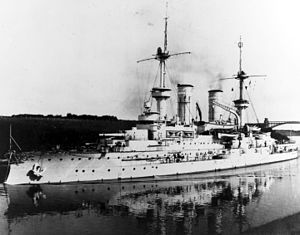 SMS Wettin in 1907
| |
| History | |
|---|---|
| Name | Wettin |
| Namesake | House of Wettin |
| Builder | Schichau, Danzig |
| Laid down | 10 October 1899 |
| Launched | 6 June 1901 |
| Commissioned | 1 October 1902 |
| Stricken | 11 March 1920 |
| Fate | Sold for scrap, 21 November 1921 |
| General characteristics | |
| Class and type | Wittelsbach-class pre-dreadnought battleship |
| Displacement | |
| Length | 126.8 m (416 ft) |
| Beam | 22.8 m (74 ft 10 in) |
| Draft | 7.95 m (26 ft 1 in) |
| Installed power |
|
| Propulsion |
|
| Speed | 18 knots (33 km/h; 21 mph) |
| Range | 5,000 nautical miles (9,300 km; 5,800 mi); 10 knots (19 km/h; 12 mph) |
| Complement |
|
| Armament |
|
| Armor | |
SMS Wettin ("His Majesty's Ship Wettin")[a] was a pre-dreadnought battleship of the Wittelsbach class of the German Kaiserliche Marine (Imperial Navy). She was built by Schichau Seebeckwerft in Danzig. Wettin was laid down in October 1899, and was completed October 1902. She and her sister ships—Wittelsbach, Zähringen, Schwaben and Mecklenburg—were the first capital ships built under the Navy Law of 1898. Wettin was armed with a main battery of four 24 cm (9.4 in) guns and had a top speed of 18 knots (33 km/h; 21 mph).
Wettin saw service in I Squadron of the German fleet for most of her career, along with her sister ships. She was occupied with extensive annual training, as well as making good-will visits to foreign countries. The training exercises provided the framework for the High Seas Fleet's operations during World War I. The ship was decommissioned in June 1911 as dreadnought battleships began to enter service but was reactivated for duty as a gunnery training ship between December 1911 and mid-1914.
After the start of World War I in August 1914, the Wittelsbach-class ships were mobilized and designated IV Battle Squadron. She saw limited duty in the Baltic Sea, but the ship played a minor role in the Battle of the Gulf of Riga in August 1915, though Wettin saw no combat with Russian forces. By late 1915, crew shortages and the threat from British submarines forced the Kaiserliche Marine to withdraw older battleships like Wettin from active service. For the remainder of the war, Wettin served as a training ship for naval cadets and as a depot ship. The ship was stricken from the navy list after the war and sold for scrapping in 1921. Her bell is on display at the Militärhistorisches Museum der Bundeswehr in Dresden.
Cite error: There are <ref group=lower-alpha> tags or {{efn}} templates on this page, but the references will not show without a {{reflist|group=lower-alpha}} template or {{notelist}} template (see the help page).